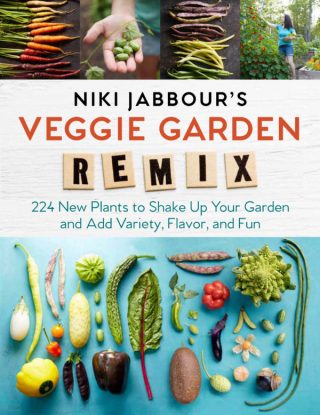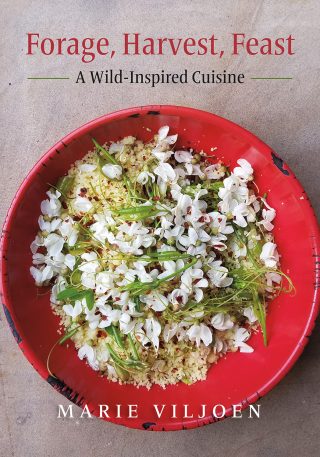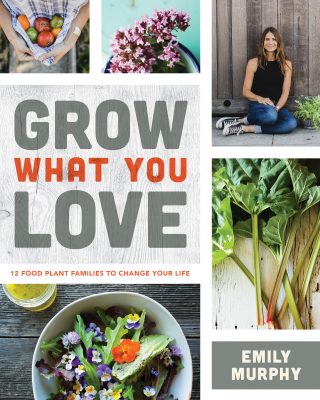Edible Plants: From Field to Garden
Posted in From the Library on September 6 2018, by Esther Jackson
Esther Jackson is the Public Services Librarian at NYBG’s LuEsther T. Mertz Library where she manages Reference and Circulation services and oversees the Plant Information Office. She spends much of her time assisting researchers, providing instruction related to library resources, and collaborating with NYBG staff on various projects related to Garden initiatives and events.
 These three new books in the Mertz Library focus on growing, foraging, and cooking edible plants. Each offers a different perspective on human and plant interactions, and will inspire readers to think about new recipes and garden ideas.
These three new books in the Mertz Library focus on growing, foraging, and cooking edible plants. Each offers a different perspective on human and plant interactions, and will inspire readers to think about new recipes and garden ideas.
Niki Jabbour’s Veggie Garden Remix: 224 New Plants to Shake Up Your Garden and Add Variety, Flavor, and Fun (2018) by gardener, author, and The Weekend Gardener radio show host (and creator) Niki Jabbour offers vegetable gardeners some new ideas to try alongside tried and true North American garden favorites. A laundry list of interesting varieties and cultivars, Veggie Garden Remix is a simple book, yet will be fun for those who like to try something a little different in their gardens. The book doesn’t include information about where to source particular varieties or cultivars from; readers may wish to investigate Seed Savers Exchange for hard-to-find recommendations.
 Forage, Harvest, Feast: A Wild-Inspired Cuisine (2018) by Marie Viljoen opens with the premise that “it is time to refresh our palates.” Viljoen, based in New York City, is an advocate for foraging and has received praise for her inventive use of foraged flora in her cuisine. Forage, Harvest, Feast will appeal to readers who are looking for inventive ways to use locally-foraged plants in their cooking. Home chefs and restaurateurs alike will find inspiration with her recipes. Viljoen, who identifies as a gardener and a cook, was raised in South Africa and active with the Botanical Society of South Africa as a young adult, moving to designing gardens in New York City (heading the garden design department of Holly, Wood, and Vine), writing books (66 Square Feet), and teaching about edible gardening and “wild foods” at NYBG and BBG. Forage, Harvest, Feast, while useful as a guide to recipes using foraged plants, is not really designed as a field guide, and readers should look to other works, such as Northeast Foraging by Leda Meredith or The Joy of Foraging by Gary Lincoff for books that offer more by way of botanical details to identify plants.
Forage, Harvest, Feast: A Wild-Inspired Cuisine (2018) by Marie Viljoen opens with the premise that “it is time to refresh our palates.” Viljoen, based in New York City, is an advocate for foraging and has received praise for her inventive use of foraged flora in her cuisine. Forage, Harvest, Feast will appeal to readers who are looking for inventive ways to use locally-foraged plants in their cooking. Home chefs and restaurateurs alike will find inspiration with her recipes. Viljoen, who identifies as a gardener and a cook, was raised in South Africa and active with the Botanical Society of South Africa as a young adult, moving to designing gardens in New York City (heading the garden design department of Holly, Wood, and Vine), writing books (66 Square Feet), and teaching about edible gardening and “wild foods” at NYBG and BBG. Forage, Harvest, Feast, while useful as a guide to recipes using foraged plants, is not really designed as a field guide, and readers should look to other works, such as Northeast Foraging by Leda Meredith or The Joy of Foraging by Gary Lincoff for books that offer more by way of botanical details to identify plants.
In general, Viljoen does not suggest foraging or preparing plants with carcinogenic properties. The notable exception to this is Phytolacca americana (pokeweed), which has historically been eaten by native people and is also recommended as a forgeable plant by both Meredith and Lincoff. Viljoen notes the toxic nature of elements of the plant, but argues that people do not eat toxic parts of other plants grown commercially, such as the fruit of asparagus or the leaves of rhubarb. I would argue that accessing the non-toxic elements of these plants through the means of agricultural production and distribution (as opposed to growing and/or harvesting them for oneself), is an additional layer of safety for consumers. But, then, I tend to be cautious about these things, whereas Viljoen is more adventurous. Regardless of how adventurous or not readers may be when it comes to foraging, either sticking to prolific European weeds, or experimenting with responsibly harvesting and ingesting native plants, the recipes that Viljoen provides are simple, inventive, and offer readers new dishes to try and new tastes to explore.
Readers should always use caution when foraging, and should be discerning about which resources they rely on. A cautionary tale involves the recent recall of another 2018 title, Tales from a Forager’s Kitchen: The Ultimate Field Guide to Evoke Curiosity & Wonderment (2018) by Johanna Holmgren. Pulled from shelves because of its recipes including raw morels, elderberry, and uncooked acorns (to say nothing of her recipes using queen anne’s lace—a close relative of poison hemlock, to which it bears a similar appearance), the scandal surrounding this title makes a strong case for informed, expert editors who are experienced and highly-trained. Publishers of similar titles will hopefully take note and vet future non-scientific foraging works more rigorously, hiring trained experts (such as botanists) as fact-checkers when possible.
 Finally, Grow What You Love: 12 Plant Families to Change Your Life (2018) by Emily Murphy is a fairly typical introductory gardening book. Replete with attractive photos and simple advice, it offers an inviting window into the world of edible gardening for those who know nothing or little of the topic. Readers wondering which 12 plant families are featured will be disappointed if they expected botanical plant families such as Lamiaceae, Apiaceae, etc. By “plant families” Murphy means groupings such as “winter greens” and “edible flowers.” Murphy is a web series host, a contributor to Better Homes and Gardens, a garden design and organic gardening consultant, and a teacher of organic gardening.
Finally, Grow What You Love: 12 Plant Families to Change Your Life (2018) by Emily Murphy is a fairly typical introductory gardening book. Replete with attractive photos and simple advice, it offers an inviting window into the world of edible gardening for those who know nothing or little of the topic. Readers wondering which 12 plant families are featured will be disappointed if they expected botanical plant families such as Lamiaceae, Apiaceae, etc. By “plant families” Murphy means groupings such as “winter greens” and “edible flowers.” Murphy is a web series host, a contributor to Better Homes and Gardens, a garden design and organic gardening consultant, and a teacher of organic gardening.

